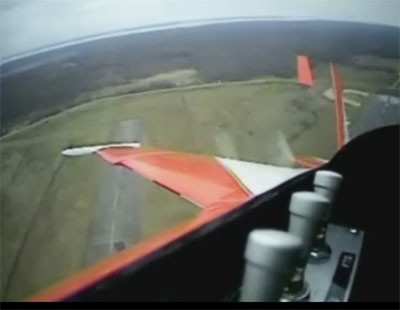Wed, May 30, 2007
Technology Holds Promise For Many Types Of Aircraft
Athena Technologies announced Wednesday the successful flight
demonstration of damage tolerant flight control and autonomous
landing capabilities on a subscale F/A-18 UAV. The Defense Advanced
Research Projects Agency (DARPA) sponsored the demonstration, which
was held on April 18, 2007 at the Aberdeen Proving Grounds in
Maryland.

The objective of the test was to prove that adaptive flight
controls could regain baseline aircraft performance after the
aircraft had sustained simulated battle damage and then safely land
the aircraft autonomously with only the onboard INS/GPS
functionality of Athena's GuideStar 111m for navigation.
The demonstration involved a subscale F/A-18 UAV, powered by a
turbojet engine, that sustained wing battle damage simulated with
the in-flight ejection of an aileron (shown above). Athena's damage
tolerant controls detected the damage in flight and adapted to the
new air vehicle configuration for the effects of the lost aileron,
recovering the baseline vehicle performance.
The vehicle then successfully landed in the damaged state with
Athena's INS/GPS-only autonomous landing system within a few feet
of the target touch down point on the airfield runway.
Damage tolerance is an enabling capability for increasing the
mission reliability of UAVs and Unmanned Combat Air Vehicles
(UCAVs) operating in hazardous and high-threat environments. The
technology provides for real-time autonomous accommodation of
damage, followed by an adaptation process that alters the flight
control system to compensate for the effects of the damage. During
the flight test, Athena demonstrated a capability that could be
applicable to all military aircraft operating in combat
environments. The technology is also relevant to any vehicle,
manned or unmanned, including civilian aircraft, that might sustain
physical damage or failures that impact controlled flight.
Athena tells ANN the demonstration highlights the challenge and
importance of the ability to autonomously land an air vehicle that
has sustained damage. This powerful capability can potentially save
the military the significant expense of lost UAVs and better
protect US proprietary technology.
More importantly, when applied to manned aircraft... the
combined technology solution could just save lives.
More News
"Fly-by-wire flight, coupled with additional capability that are being integrated into ALFA, provide a great foundation for Bell to expand on its autonomous capabilities. This airc>[...]
Hold Procedure A predetermined maneuver which keeps aircraft within a specified airspace while awaiting further clearance from air traffic control. Also used during ground operatio>[...]
Aero Linx: B-21 Raider The B-21 Raider will be a dual-capable penetrating strike stealth bomber capable of delivering both conventional and nuclear munitions. The B-21 will form th>[...]
Also: Virgin Galactic, B-29 Doc to Allentown, Erickson Fire-Fighters Bought, FAA Reauthorization After dealing with a big letdown after the unexpected decision by Skyreach to disco>[...]
Also: Skydio Chief, Uncle Sam Sues, Dash 7 magniX, OR UAS Accelerator US Secretary of the Air Force Frank Kendall was given a turn around the patch in the 'X-62A Variable In-flight>[...]
 Aero-News: Quote of the Day (05.09.24)
Aero-News: Quote of the Day (05.09.24) ANN's Daily Aero-Term (05.09.24): Hold Procedure
ANN's Daily Aero-Term (05.09.24): Hold Procedure ANN's Daily Aero-Linx (05.09.24)
ANN's Daily Aero-Linx (05.09.24) Airborne 05.03.24: Advanced Powerplant Solutions, PRA Runway Woes, Drone Racing
Airborne 05.03.24: Advanced Powerplant Solutions, PRA Runway Woes, Drone Racing Airborne-NextGen 05.07.24: AI-Piloted F-16, AgEagle, 1st 2 WorldView Sats
Airborne-NextGen 05.07.24: AI-Piloted F-16, AgEagle, 1st 2 WorldView Sats



